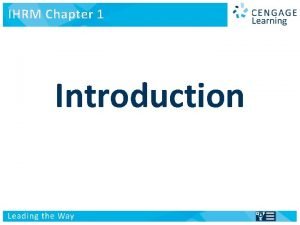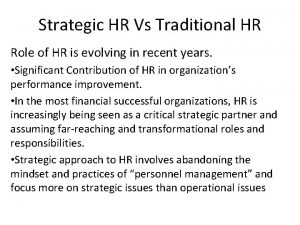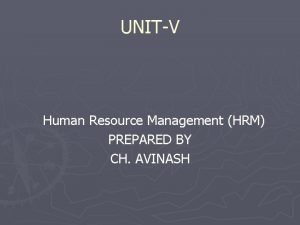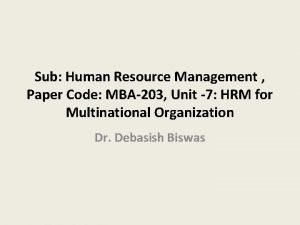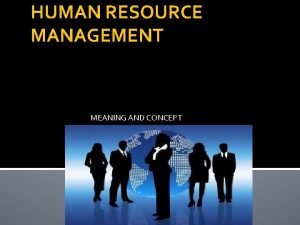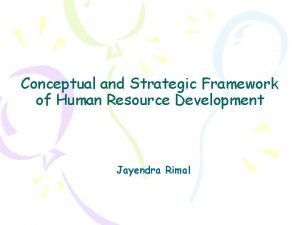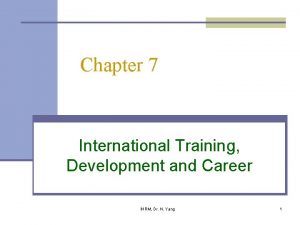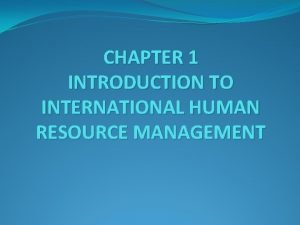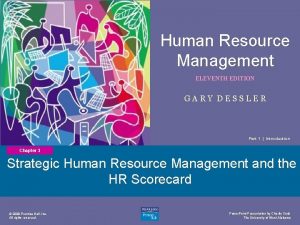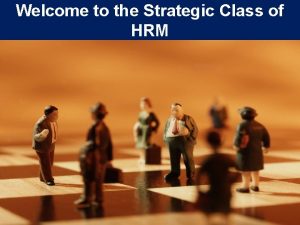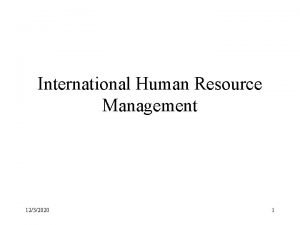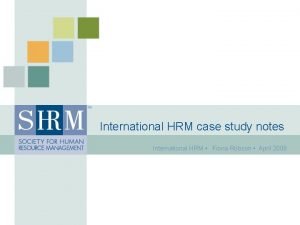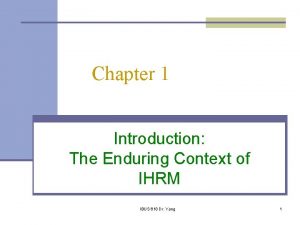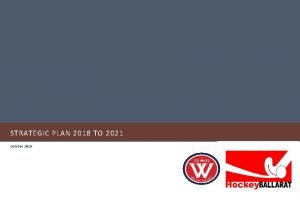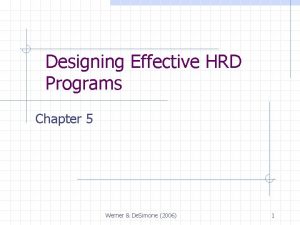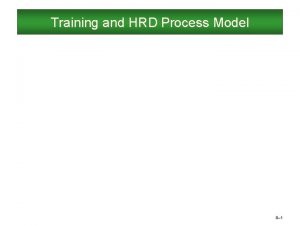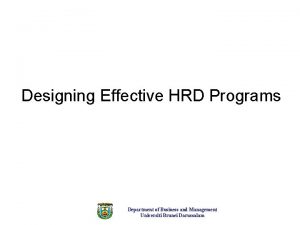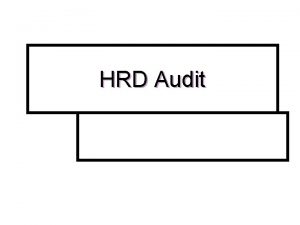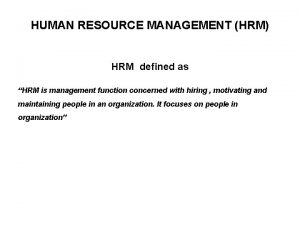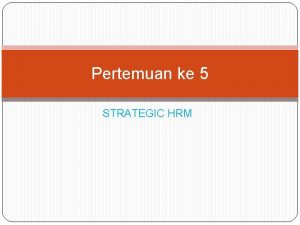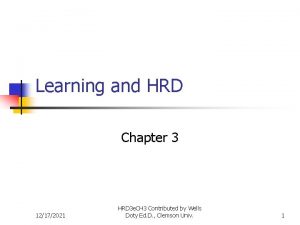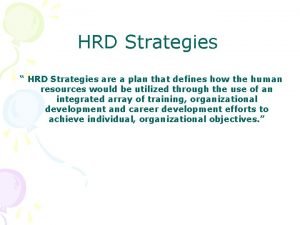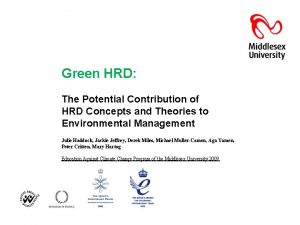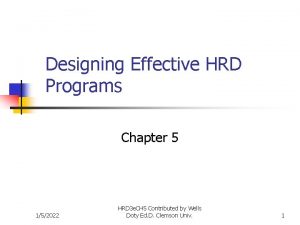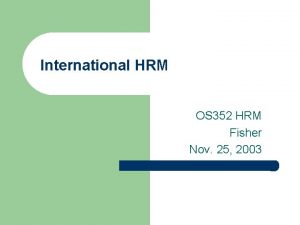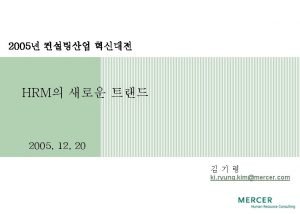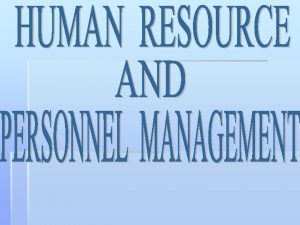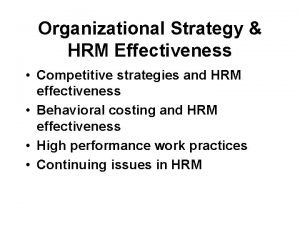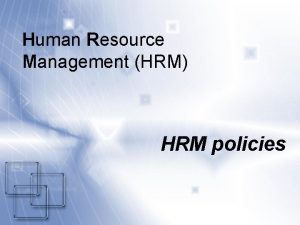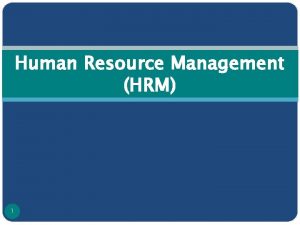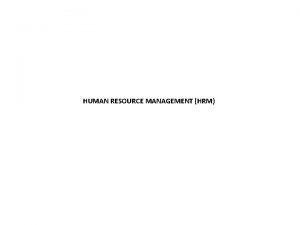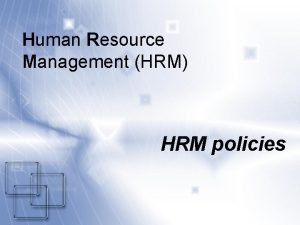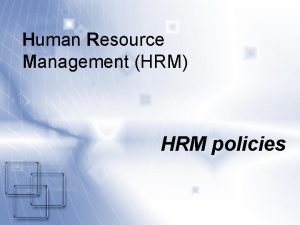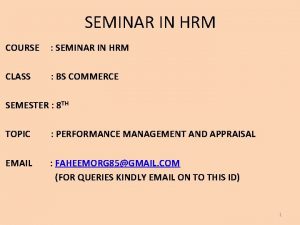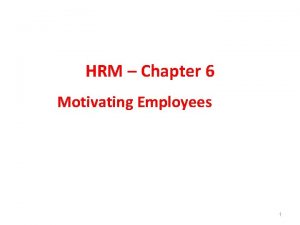1 International HRM 2018 HRD and strategic growth





























- Slides: 29

1 International HRM: 2018 HRD and strategic growth from within Training or Learning and Development?

2 Recap

Job competence and traditional selection methods Job competence requirement Traditional selection methods: e. g. -cv -interview 3

Evaluating selection techniques Validity + reliability = prediction 0 = Inability to predict / 1 = Perfect prediction • • Interview - normal Interview – behavioural References Work sampling Personality assessment Cognitive ability assessments Manual ability assessments Graphology = 0. 17 = 0. 42 = 0. 13 = 0. 57 = 0. 40 = 0. 54 = 0. 73 = 0. 17 4

Behavioural interviewing • Situational-behavioural questioning – • The most important technique to improve validity and reliability • This technique involves: • Identifying key behaviours required to be effective in the job • Asking candidates to describe actual situations in which they personally have demonstrated these behaviours • Probing questions are used to ascertain the candidates’ exact behaviours 5

Selection. . . The Apprentice style Job Competence Assessment exercises and tests 6

Rigorous selection: evidence • Rigorous selection involves the use of a range of techniques: • Assessments / tests (analytical assessment) • Manual • Cognitive • Personality • Activities (analogous assessment) • Presentations • Group work • In-box • Role play • Work sampling (actual assessment) • Job trial / Portfolio of material 7

8 from selection to Development

Knowledge and learning = CA + well-being • Knowledge and learning need to be managed • “In a knowledge-based economy … there is constant change and … people are regularly required to develop new knowledge and skill … the key to becoming and remaining a successful organisation” (Foot, 2017) • “The global organisation and its individual members must constantly reinvent themselves” (Schuller et al. , 2016) 9

Knowledge and learning = CA + well-being • To stay competitive the knowledge of workers must be harnessed, shared and expanded … • Knowledge is CA for firms and for nations … • Enabling all members of the organisation to realise their potential … to thereby grow organisations from within • EU agenda of life-long learning for all citizens – learning is essential to social cohesion and inclusion and individual wellbeing and quality of life 10

What is learning? • Learning as both a noun and as a verb • Learning as outcomes (noun): “a relatively permanent change in behaviour as a result of individuals’ understanding (making meaning or personal sense) of information or stimuli” 11

What is learning? • Components: • Knowledge • Skill • Attitude (to some extent tacit) • Learning as process (verb): “a relatively permanent change in behaviour that occurs as a result of practice or experience” • Learning outcome type (K, S, A) = learning method 12

Planes of learning: a typology 13

Socio-economic context of HRD 14

International contrasts in State role in learning § Minimalist State role (“it’s the individual’s responsibility”) e. g. USA: § Providing basic education as a preparation for work – literacy and numeracy § Intermediate State role (“it’s the responsibility of individuals & firms”): § Additionally providing / supporting § Higher education – vocational courses § Tax allowances for organisations that train their staff § Regulatory State role (“it’s a shared responsibility”) e. g. France: § Additionally providing / regulating specific vocational training … § Specifying apprenticeship arrangements including pay § Specifying curricula for college training § Setting assessment standards & methods § Requiring % of salary bill to be spent on training (e. g. 3% min. ) § Providing financial incentives such as tax free training / leave entitlements § Providing free or subsidized higher education ? What are the arguments for Minimalism and for Regulation? 15

Organisational context of HRD 16

Stages of learning & training in the firm Stage 1: Clear business strategy Stage 2: Identify group / individual learning need/s: learning outcomes* required Stage 3: Design learning and development activity: matching learning methods with outcomes Stage 4: Implement development activity * Learning outcomes are specified in terms of: - Knowledge - Skills - Attitudes Stage 5: Evaluate development for individuals and the firm 17 ……

Individual learning differences • Learning motivation: • Intrinsic • Extrinsic • Learning styles differ significantly by culture: • Activist (learns best by trial and error) • Reflector (learns best by thinking about experience) • Theorist (learns best by understanding principles first) • Pragmatist (learns best by experimenting) • Learning readiness: • Less ready: need planned learning activities • More ready: able to exploit incidental learning opportunities 18

Types of learning • 70/20/10 … • 70% of learning is informal from personal experiences in work • 20% of learning is informal from social interactions in work • 10% of learning is formal from courses related to work 19

“Every class I teach is a learning experience for me as much as the students” [school teacher with 32 years of teaching experience, 2018] 20

Sources of informal learning In the short video clip: ① What principles of business are being learnt? ② How are those principles of business being learnt? ③ How is the learner being enabled to learn? ④ In what ways could a university education in business accelerate or enhance such learning? https: //www. youtube. com/watch? v=g 0 O 6 VAbn. Dt 8 https: //www. youtube. com/watch? v=g 0 O 6 VA bn. Dt 8 21

learning training education

The limits of formal learning: the ‘transfer problem’ Perhaps 85% of learning that contributes to work effectiveness takes place within the workplace The key problem with “off-the-job” learning, is transfer: as little as 5%: 23

Diversity of occupational learning methods • A distinction is made between: • Off-the-job learning methods Which can occur through: a) Formal means e. g. participating in formal training courses b) Informal means e. g. acting as an officer of a sports or social club • On-the-job (“integrated”) learning methods This can take two forms: a) Learning via interventions in work processes e. g. verbal instruction or coaching b) Learning that is embedded in ordinary work activities e. g. trial and error, reflection on experience 24

Off-the-job learning methods – purposes • Guided reading / web-resources • Acquiring knowledge at own pace • Lectures • Transmission of latest knowledge to large numbers • Discussions • Exchange of knowledge, development of understanding • Role-play • Practicing inter-personal skills in challenging situations • Case study • Diagnosis and problem solving; application of theory • Projects • Managing a substantial task; creative problem solving 25

On-the-job learning • On-the-job learning – perhaps 85% of all occupational learning … “occurs naturally through engagement in meaningful situations” • Difficult to recognise: learning is incidental and knowledge is tacit • Approximately 85% of all on-the-job learning is unplanned and incidental to normal working • Examples: solving a difficult problem at work / dealing with a difficult customer or client • Most people have plenty of different experiences but fail to learn from them … • reflection on experience is needed 26

On-the-job learning: methods overview • Purposeful learning: • Direct on-the-job instruction • Shadowing • Responsibility broadening: job rotation • Responsibility enhancing: job enrichment • Responsibility enhancing: delegation • Secondments within or outside the organisation • Blendid training: instruction – experience – instruction • Coaching – guidance and support in mastering a specific skill • Mentoring –developmental guidance in developing skills & attitudes • Incidental learning from self and others: • Experience: trial, error, re-trial … success • Experience: reflection (”what can I learn from this? ”) • Experience: emerging challenges or problems • Role modeling or Role reacting • Participating in a knowledgeable / skillful group • Interacting with clients, customers or suppliers 27

Evaluating learning • Establishing the Return on Investment • Problem of establishing: • Training = corporate success • Corporate success = training • Evaluation can be straightforward: a specific skill / area of knowledge • Evaluation can be problematic: a process of education • If the learning intervention is focused on the real learning needs then evaluation might be less problematic • Use of post-course evaluation questionnaires: • evaluate the course and not the learning 30

Levels of evaluation • Level 1 evaluation … • of the training – have the objectives been met: • Reaction of learners • Level 2 evaluation … • of the learning – how the learner now behaves • Testing learners before and after • Level 3 evaluation … • of changes in job performance • Level 4 evaluation … • of changes in colleagues’ / team performance • Level 5 evaluation … • of changes in organisational performance 31
 Define international human resource management
Define international human resource management Traditional hr approach
Traditional hr approach Dale yoder hrm
Dale yoder hrm Sub-human resources
Sub-human resources Function of personnel management
Function of personnel management Hrm vs hrd
Hrm vs hrd Conceptual framework of human resource development
Conceptual framework of human resource development Training in ihrm
Training in ihrm Difference between international and domestic hrm
Difference between international and domestic hrm Hr-strategy map
Hr-strategy map Strategic hrm models
Strategic hrm models Establishing strategic pay plans in hrm
Establishing strategic pay plans in hrm Dada la siguiente secuencia rusia 2018 rusia 2018
Dada la siguiente secuencia rusia 2018 rusia 2018 Plant growth definition
Plant growth definition Eudicot
Eudicot Primary growth and secondary growth in plants
Primary growth and secondary growth in plants Chapter 35 plant structure growth and development
Chapter 35 plant structure growth and development Human resource management meaning
Human resource management meaning Transnational multinational global international
Transnational multinational global international Short case study on international hrm with solution
Short case study on international hrm with solution Laurent's steps to truly international hrm
Laurent's steps to truly international hrm Strategic complements example
Strategic complements example Resource based model
Resource based model Strategic analysis and choice in strategic management
Strategic analysis and choice in strategic management Strategic plan 2018 to 2021
Strategic plan 2018 to 2021 Hrd program implementation
Hrd program implementation Designing effective hrd programs
Designing effective hrd programs Training and hrd process model
Training and hrd process model Hrd design
Hrd design Step growth polymerization vs chain growth
Step growth polymerization vs chain growth
